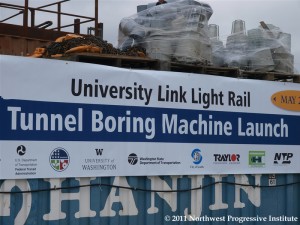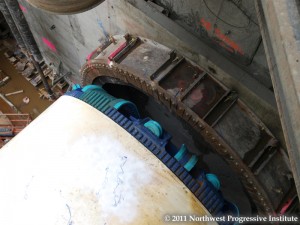Let the tunneling begin!
This morning, at the University of Washington’s Husky Stadium, Senator Patty Murray, Federal Transit Administrator Peter Rogoff, and local elected officials gathered to join Sound Transit in christening the boring machines that will excavate the tunnels between the U‑District station at Husky Stadium and the Capitol Hill station at Broadway and Denny.

University Link, which is scheduled to open in 2016, will extend light rail from downtown Seattle to the University of Washington via Capitol Hill.
Much of the funding ($813 million of the total $1.9 billion) is being provided by the federal government, in recognition of the strong ridership potential and the positive economic impact that the project represents.
““The University Link project is already creating quality jobs here Seattle, and it is going to be great for local commuters and the community when it opens in 2016,” Senator Patty Murray said in a statement.
Interim UW President Phyllis Wise added, “Today marks another milestone in the progress Sound Transit is making in constructing our region’s light rail system. Each step brings us closer to the day when people throughout the region will be able to commute to the University by train. We are eager for the digging to commence and look forward to the day when this station is complete and the trains begin to arrive.”
At today’s event, bottles of champagne were placed on a line tethered to the two tunnel boring machines, and dropped against the side.
The machines, nicknamed Togo and Balto, are already in place, having been lowered by the contractors to the bottom of the hole that’s been excavated to the immediate southwest of Husky Stadium.They will operate between one hundred and three hundred feet underground on their journey south.
Togo and Balto were manufactured by Herrenknecht, a German firm specializing in tunneling. They each weigh around 503.4 metric tons, and were fabricated near the Port of Tacoma by Jesse Engineering. Nearly forty-five truck loads were needed to bring the TBMs and their trailing machinery to Montlake.
Each TBM is divided into three parts. The forward shell (which houses the cutterhead and the main drive), the stationary shell (home to the propulsion system and steering) and the trailing shield, which contains the equipment needed to excavate the spoils and lay tunnel segments.
Sound Transit permitted myself and photographers from several other media outlets to descend into the shaft so we could get a better view of the TBMs. They’re actually hard to see from the surface; there’s a lot of girders that obstruct the view.
Here’s a shot from the top:

And here’s the view from the bottom of the stairwell:

The machines will break into the soil later this week. The cutterheads will spin at between 0.1 to 2.5 revolutions per second as they excavate. Excavation will continue until mid-2013, so the contracting teams will be tunneling for an estimated two years. That’s actually not such a long timeframe, considering that the entire University Link extension is underground (there are no at grade sections).
Station construction is the next priority. That’s expected to continue until mid-2015. Systems testing will then follow, and the line will open in 2016.

The UW station is scheduled to be completed first, in early 2015. The Capitol Hill station should be done in late summer or early autumn of that year.
It’s really exciting to see University Link moving forward. I remember when the Emerald Mole was launched in 2006 to dig the Beacon Hill tunnels for Central Link. That was certainly a momentous occasion, as today is.
As Sound Transit’s planners know, getting between downtown and the U‑District is presently very challenging during rush hour, even for commuters taking a bus like the 545 Express. When it opens, University Link will offer a reliable commute between these two vital neighborhoods, no matter what the traffic or the weather are like. That day simply cannot come soon enough.
